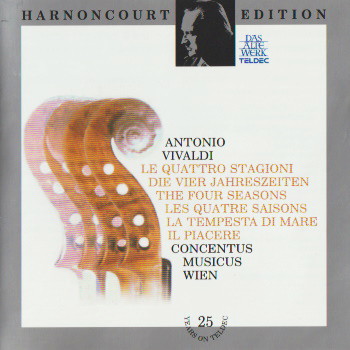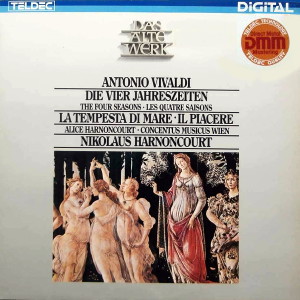 |
1 CD -
Teldec 8.42985 XH (c) 1989
|
 |
| 1 LP -
Tedec 6.42985 AZ (p) 1977 |
|
| NIKOLAUS HARNONCOURT - 25 Years
on TELDEC |
|
|
|
|
|
|
|
| Antonio Vivaldi
(1678-1741) |
Il Cimento
dell'Armonia e dell'Inventione -
Concerti Op. 8 Nr. 1-6 |
|
|
|
|
|
|
|
|
|
Concerto
I E-dur "La Primavera", F. I/22
(PV 241) |
|
8' 09" |
A1
|
|
- Allegro |
3' 06"
|
|
|
|
- Largo |
1' 50"
|
|
|
|
-
Allegro, Danza Pastorale |
3' 13"
|
|
|
|
Concerto
II g-moll "L'Estate", F. I/23 (PV
336) |
|
10' 53" |
A2
|
|
- Allegro non molto |
5' 40"
|
|
|
|
-
Adagio/Presto |
2' 18"
|
|
|
|
-
Presto, Tempo impetuoso d'Estate |
2' 48"
|
|
|
|
Concerto
III F-dur "L'Autunno", F. I/24 (PV
257) |
|
9' 23" |
A3
|
|
-
Allegro, Ballo e Canto de' Villanelli |
4' 04"
|
|
|
|
- Adagio, Ubriachi dormienti |
2' 33"
|
|
|
|
-
Allegro, la caccia |
2' 46"
|
|
|
|
Concerto
IV f-moll "L'Inverno", F. I/25 (PV
442) |
|
7' 47" |
B1
|
|
-
Allegro non molto |
3' 29"
|
|
|
|
- Largo |
1' 08"
|
|
|
|
-
Allegro |
3' 10" |
|
|
|
Concerto
V B-dur "La Tempesta di Mare", F.
I/26 (PV 415) |
|
8'
33"
|
B2
|
|
-
Presto |
2' 38" |
|
|
|
- Largo |
2' 28" |
|
|
|
-
Presto |
3' 27" |
|
|
|
Concerto
VI C-dur "Il Piacere", F. I/27 (PV
7) |
|
7'
26"
|
B3
|
|
-
Allegro |
2' 40" |
|
|
|
- Largo |
2' 07" |
|
|
|
-
Allegro |
2' 39" |
|
|
|
|
|
|
|
| CONCENTUS MUSICUS
WIEN (mit Originainstrumenten) |
|
| - Alice Harnoncourt,
Violino prncipale |
|
| - Jürg Schaeftlein,
Hautbois |
|
| - Walter Pfeiffer,
Peter Schoberwalter, Wilhelm Mergl,
Anita Mitterer, Richard Motz, Ingrid
Seifert, Veronika Schmidt (5,6),
Alison Bury (1-4), Violinen |
|
| - Kurt Theiner,
Josef de Sordi, Viola |
|
| - Nikolaus
Harnoncourt, Violoncello |
|
| - Eduard Hruza, Violone |
|
| - Herbert Tachezi, Orgel,
Cembalo |
|
| Nikolaus
HARNONCOURT, Leitung |
|
|
|
|
|
Luogo
e data di registrazione |
|
Casino
Zögernitz, Vienna (Austria) -
ottobre 1976 e marzo 1977 |
|
|
Registrazione:
live / studio |
|
studio |
|
|
Producer
|
|
Heinirich
Weritz |
|
|
Edizione CD |
|
TELDEC
- 8.42985 XH (243 005-2) - (1 CD -
durata 53' 42") - (c) 1989 - ADD |
|
|
Originale LP
|
|
TELDEC
- 6.42985 AZ - (1 LP - durata 53'
42") - (p) 1977 - Analogico |
|
|
Note |
|
-
|
|
|
|
|
|
Vivaldi wrote the
majority of his numerous
concertos for his own ensemble,
the famous girls orchestra of
the "Ospedale della Pietà" in
Venice. As from 1704 Vivaldi was
employed as violin teacher and
from about 1716 as "maestro dei
concerti" at this institution,
which was a kind of foundlings
or orphans home and of which
there were several in Venice at
that time.
Concerning the programme of the
pieces in detail. Vivaldi
transferred the sonetts to the
seasons so accurately into tone
language that he marked with
letters the places in the parts
which corresponded with certain
lines of the sonett. Frequently
the musical figures overlap each
other, for instance when the dog
barks while the shepherd is
sleeping and the leaves rustle
in the wind, or when the fleeing
game is being shot at...
In the first concerto "La
Primavera", the appearance of
spring is represented so to
speak with heralds, in an
absolutely theatrical manner.
The heavy breathing, the
languishing in the summer heat,
is depicted in the utmost
pianissimo; the slightest
movement is immediately followed
by exhaustion.
The autumn concerto starts with
a merry peasant dancing song.
The solo violin plays the role
here of the choir leader who
repeats and embellishes the
chorus verses. Vivaldi paints
pure enjoyment the drunken
peasant in all the phases of his
condition, repeatedly
interrupted by the general folk
song.
Freezing in the winter cold is
expressed on the one hand by a
sharp bowed vibrato (similar
alto to other frost scenes
around 1700), and on the other
by cutting dissonances; in the
first violin part even by means
of a trill-like two-finger
vibrato.
The programmes of the other
concertos are much farther
ranging and more abstract than
the seasons concertos. In "La
tempesta di Mare" the stormy sea
is painted with its huge wawes
rolling in from afar, building
up with increasing closeness and
continuously, so to speak
syncoptically, with foam-covered
tips tumbling over each other.
In the concerto "Il Piacere"
(Joy) from the very outset
embellished fifth leaps and
symcopation depict jubilating
joy. The slow movement with its
12/8 siciliano rhythm is
apparently a description of
nature; during the baroque
period pastoral scenes were
always, of course, signs of
harmony, of pure, innocent joy.
|
|

